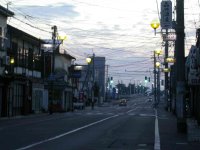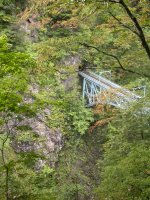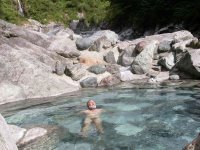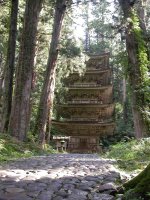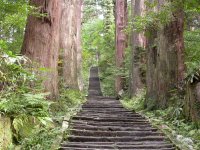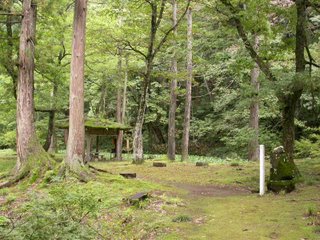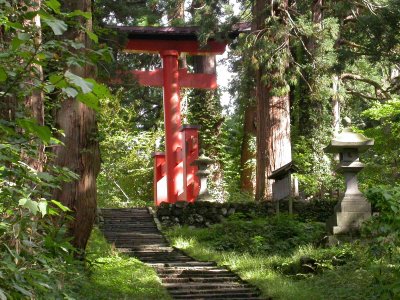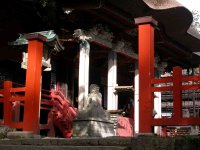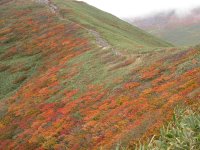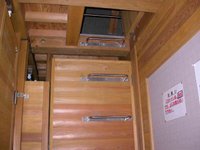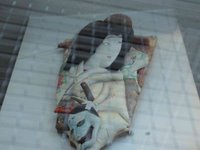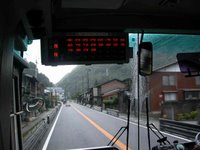
Boring, these Japanese
If there’s a mountain in the way
They bore right through it
Long day getting to Takayama. Basho did not come this way, either, but they’re having the Hachiman Matsuri (Autumn Festival) and it’s the only festival occuring anywhere near his route this late in the year.
I take the train to Toyama, then have to switch to the bus as the trainline was swept away in a taifun. Soon I’m the only person on the basu. This is quite a common occurrence, me being chauffeured around in an 80
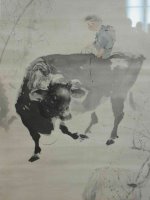 -seater bus all by myself. I’m told that the reason for this is that, due to the exingencies of the Japanese electoral representation system, the representatives of ‘back-of-beyond’ constituencies have considerable power, so money pours in to butter them up. This money then has to be spent - on totally uneconomic rural bus-services which few use, brightly-lit UFO ‘visitor centres’ plumped down in the middle of nowhere, the hills being given concrete overcoats; and other things which are either downright harmful (such as gigantic concrete coastal ‘tank-trap’ structures ‘to prevent erosion’ which destroy the local ecology) or which nobody needs or wants.
-seater bus all by myself. I’m told that the reason for this is that, due to the exingencies of the Japanese electoral representation system, the representatives of ‘back-of-beyond’ constituencies have considerable power, so money pours in to butter them up. This money then has to be spent - on totally uneconomic rural bus-services which few use, brightly-lit UFO ‘visitor centres’ plumped down in the middle of nowhere, the hills being given concrete overcoats; and other things which are either downright harmful (such as gigantic concrete coastal ‘tank-trap’ structures ‘to prevent erosion’ which destroy the local ecology) or which nobody needs or wants.The busdriver is the non-speaking, morose type, hunched over his steering wheel as the hours tick past. The girl at Toyama Informat
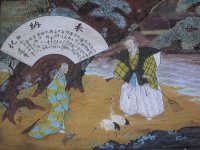 ion Centre (too much makeup) had said 1 ½ hours to Hirayu, but 2 hours have elapsed and we’re still grinding uphill, past squeaky clean Alpine style honey-pot resorts with posh cars parked outside, and I'm worried about making my connection.
ion Centre (too much makeup) had said 1 ½ hours to Hirayu, but 2 hours have elapsed and we’re still grinding uphill, past squeaky clean Alpine style honey-pot resorts with posh cars parked outside, and I'm worried about making my connection.After 2 ½ hours we’re there. Mr Grumpy wordlessly points to a well-lit lobby. I rush over – no information centre – and throw myself on the mercy of a snack-stand girl who takes me to the bus-stop and checks the times for me.
5 minutes later my connection draws up. The Takayama bus has a few pa
 ssengers, a sweet young stewardess and a chirpy, smiling driver wisecracking with the passengers. No doubt he’s chirpy because he has her, unlike Mr Morose who has nobody. The stewardess tries out her best English on me, but can’t do times and prices, so she writes them down. 1540 yen (£8), arrive Takayama 18.30. She has this totally Japanese (and un-English) quality of ‘other-centredness’ – when she talks to you her whole being is focussed towards you and what you could want, not towards herself. Do they learn this, are they taught, or does it just reach out?
ssengers, a sweet young stewardess and a chirpy, smiling driver wisecracking with the passengers. No doubt he’s chirpy because he has her, unlike Mr Morose who has nobody. The stewardess tries out her best English on me, but can’t do times and prices, so she writes them down. 1540 yen (£8), arrive Takayama 18.30. She has this totally Japanese (and un-English) quality of ‘other-centredness’ – when she talks to you her whole being is focussed towards you and what you could want, not towards herself. Do they learn this, are they taught, or does it just reach out? 
I roll into Takayama Bus Station dead on 6.30 pm and ask a young couple strolling past where the YH is. The guy stutters a bit but the girl looks at me from somewhere way beyond time and space, takes me by the arm, leads me to the corner and points. “Straight down the road,” she says, you can’t miss it.”
I check in, dump my stuff, freshen up, and find a noodle bar. Kirin biiru, soba noodles and prawn tempura. Ahhh. A brassy number in a short black skirt and very high heels flounces in, so I ask her if she speaks Ingrish, which she does. So we do. She flounces out again with a sm
 ile and a wriggle. An older woman, well done up 'with an air' comes in and eyes me up, chats to the mama-san. Oh yes, oh yes, I'm starting to get the picture: must be 'a certain part of town'. Uh huh. Any man that lot get their well manicured highly polished claws into wouldn't last 10 seconds. Sucked dry and spat out. Phut. Come to think of it, brassy number had a very deep voice for a woman, especially a Japanese woman...
ile and a wriggle. An older woman, well done up 'with an air' comes in and eyes me up, chats to the mama-san. Oh yes, oh yes, I'm starting to get the picture: must be 'a certain part of town'. Uh huh. Any man that lot get their well manicured highly polished claws into wouldn't last 10 seconds. Sucked dry and spat out. Phut. Come to think of it, brassy number had a very deep voice for a woman, especially a Japanese woman...[satellite link: you can zoom in on individual cars in Takayama if you want]

